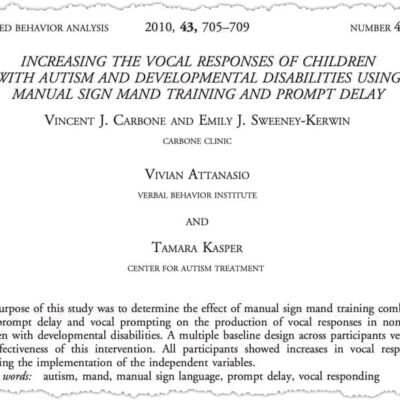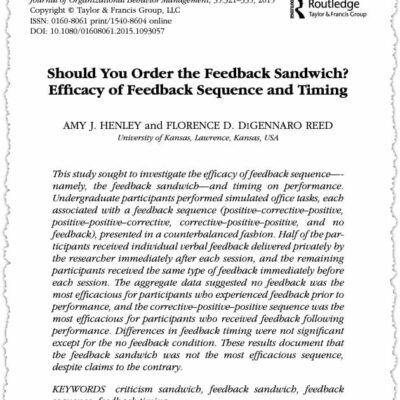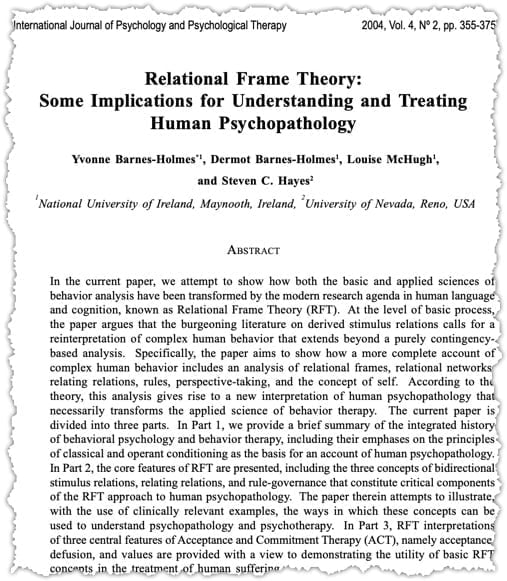Relational Frame Theory: Some Implications for Understanding and Treating Human Psychopathology
$14.99
BCBA CEUs: 1.5 CEUs
Read the following article and pass an 8-question quiz on it:
Barnes-Holmes, Y., Barnes-Holmes, D., McHugh, L., & Hayes, S. C. (2004). Relational frame theory: Some implications for understanding and treating human psychopathology. International Journal of Psychology and Psychological Therapy, 4, 355-375.
Brand: CEUniverse
Description
To earn credit, you will be required to read the article and pass an 8-question quiz about it. You can retake the quiz as many times as needed, but you will not receive exactly the same questions each time.
Abstract
In the current paper, we attempt to show how both the basic and applied sciences of behavior analysis have been transformed by the modern research agenda in human language and cognition, known as Relational Frame Theory (RFT). At the level of basic process, the paper argues that the burgeoning literature on derived stimulus relations calls for a reinterpretation of complex human behavior that extends beyond a purely contingency-based analysis. Specifically, the paper aims to show how a more complete account of complex human behavior includes an analysis of relational frames, relational networks, relating relations, rules, perspective-taking, and the concept of self. According to the theory, this analysis gives rise to a new interpretation of human psychopathology that necessarily transforms the applied science of behavior therapy. The current paper is divided into three parts. In Part 1, we provide a brief summary of the integrated history of behavioral psychology and behavior therapy, including their emphases on the principles of classical and operant conditioning as the basis for an account of human psychopathology. In Part 2, the core features of RFT are presented, including the three concepts of bidirectional stimulus relations, relating relations, and rule-governance that constitute critical components of the RFT approach to human psychopathology. The paper therein attempts to illustrate, with the use of clinically relevant examples, the ways in which these concepts can be used to understand psychopathology and psychotherapy. In Part 3, RFT interpretations of three central features of Acceptance and Commitment Therapy (ACT), namely acceptance, defusion, and values are provided with a view to demonstrating the utility of basic RFT concepts in the treatment of human suffering.
17 reviews for Relational Frame Theory: Some Implications for Understanding and Treating Human Psychopathology
| 5 star | 70 | 70% |
| 4 star | 11 | 11% |
| 3 star | 17 | 17% |
| 2 star | 0% | |
| 1 star | 0% |
Sorry, no reviews match your current selections
You may also like…
-
Multimedia Tutorial

7 BCBA CEUs
An Introduction to Relational Frame Theory (RFT)
Eric J. Fox4.55 out of 5(503)$69.99 Add to Cart Quick View -
BundleSale!

20 Total BCBA CEUs
4 Ethics CEUs16 General CEUsCelestial Bundle
$199.91Original price was: $199.91.$139.91Current price is: $139.91. Add to Cart Quick View -
Article Quiz

1.5 BCBA CEUs
Establishing a Deictic Relational Repertoire in Young Children
Timothy M. Weil, Steven C. Hayes, & Philip Capurro4.55 out of 5(20)$14.99 Add to Cart Quick View
Related products
-
Article Quiz

0.5 BCBA CEU
Increasing the Vocal Responses of Children with Autism and Developmental Disabilities Using Manual Sign Mand Training and Prompt Delay
Vincent J. Carbone, Emily J. Sweeney-Kerwin, Vivian Attanasio, & Tamara Kasper4.67 out of 5(24)$4.99 Add to Cart Quick View -
Multimedia Tutorial

1 Total BCBA CEU
1 Ethics CEUABA Terminology for Effective Practice
Melissa Mackal & Robert Wallander4.67 out of 5(43)$9.99 Add to Cart Quick View -
Article Quiz

1 Total BCBA CEU
1 Supervision CEUShould You Order the Feedback Sandwich? Efficacy of Feedback Sequence and Timing
Amy J. Henley & Florence D. DiGennaro Reed4.74 out of 5(31)$9.99 Add to Cart Quick View





I very much enjoyed this article. The implications and applications are far-reaching, and I was able to use the information almost immediately in thinking outside of the box for one of my students!
Informative and easy to follow
interesting
Very informative!